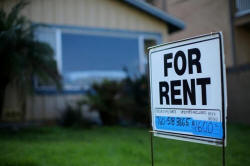U.S. renters look for last-gasp window to buy
 Send a link to a friend
Send a link to a friend
 [March 02, 2018]
By Gail MarksJarvis [March 02, 2018]
By Gail MarksJarvis
CHICAGO (Reuters) - (The opinions expressed
here are those of the author, a columnist for Reuters.)
People trying to escape soaring rents in U.S. cities face a cruel
reality: home prices are going up, too.
Still, many potential homeowners are finding that as expensive as it is
to buy a house, now may be the last opportunity before mortgage rates
start to rise.
Buying a home is more affordable than renting in only nine of 39 major
metropolitan areas, according to research firm ATTOM Data Solutions:
Dallas, Miami, San Antonio, Detroit, Philadelphia, Tampa-St. Petersburg,
Cleveland, Pittsburgh and St. Louis.
Good luck affording either in the other markets.
This is why Amanda Wright, 35, and her husband Todd, 33, recently
decided to buy in Seattle, where home prices rose more than 14 percent
last year.

“It’s a really challenging time for a buyer,” said Wright, a real estate
broker. The financial planning rule of thumb is to spend no more than 30
percent of a family’s monthly income on housing, but “it is nearly
impossible to follow that guideline now in Seattle.”
Residents in Seattle, on average, are spending 40.2 percent of pay for a
three-bedroom rental, according to ATTOM Data Solutions research based
on U.S. Bureau of Labor Statistics and Department of Housing and Urban
Development data. Buying the median priced Seattle area home at $613,500
demands 62.5 percent of pay.
In Brooklyn, people on average would spend 67.4 percent of their pay on
rent, but buying the median priced home at $640,000 would require 110.9
percent of pay. In the San Francisco area, which has the highest
income-to-housing cost ratios in the country, rent takes 79 percent of
pay, and 136 percent of pay to buy the median home at $1.17 million.
At those prices, “renting is the lesser of two housing evils,” said
Daren Blomquist, senior vice president of ATTOM Data Solutions.
The good and bad news down the road involves mortgage interest rates. If
they climb as expected to near 5 percent this year, home payments will
cost more.
[to top of second column] |

A "For Rent" sign is posted outside a residential home in Carlsbad,
California, U.S., January 18, 2017. REUTERS/Mike Blake

Although that will price some people out of the housing market, it could
also cause prices to decline as demand drops, said Blomquist. Early
cracks in the housing market seemed to show up in January, when existing
home sales fell 3.2 percent.
“Affordability is getting worse and something’s got to give,” said
Blomquist. “Mortgage rates put more pressure on the affordable pressure
cooker.”
Last week the average 30-year mortgage rate was 4.4 percent, according
to mortgage finance agency Freddie Mac, compared to 3.9 percent late in
2017. On a $380,000 home, that lifts monthly payments by about $100.
Based on rates alone, a jump from 4 percent to 5 percent could cause the
nation’s home sales volume to drop by 300,000, said National Association
of Realtors economist Lawrence Yun. Last year about 6.1 million new and
existing homes were sold. But, he said, a strong economy and job growth
could mitigate a decline.
Among those motivated to move now, before things get more expensive, is
Ray Jess, 32. He was hesitant to stretch past that 30 percent ratio of
income to housing cost after watching his parents generation struggle
financially, but buying something won out. His starter home, which he
purchased with his wife in Chicago last week, will be the first floor of
a duplex.
“My wife and I were concerned that the longer we waited, the house we
could buy would become less and less nice,” Jess said.

(Editing by Beth Pinsker and Ben Klayman)
[© 2018 Thomson Reuters. All rights
reserved.] Copyright 2018 Reuters. All rights reserved. This material may not be published,
broadcast, rewritten or redistributed.
Thompson Reuters is solely responsible for this content. |